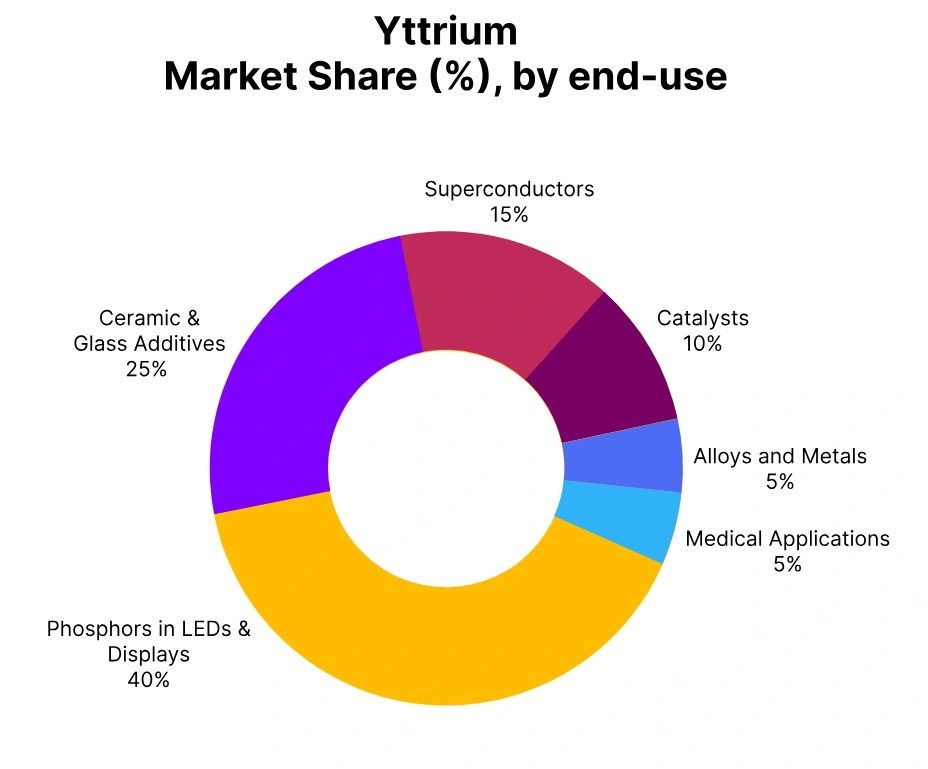Price-Watch’s most active coverage of Yttrium price assessment:
- Purity:99%min. FOB Shanghai, China
- Purity:99%min. CIF Nhava Sheva (China), India
- Purity:99%min. CIF Houston (China), USA
- Purity:99%min. CIF Rotterdam (China), Netherlands
Yttrium Price Trend Q3 2025
In Q3 2025, yttrium prices showed a mixed trend globally, with stable to slightly rising prices in Asia Pacific driven by steady demand in high tech and green technologies, while prices softened in North America and Europe due to weaker industrial demand and competitive Chinese exports.
Supply constraints from mining challenges and geopolitical factors, including export restrictions, supported price resilience despite regional fluctuations. Overall, the market balanced steady demand in electronics, renewable energy, and medical applications against supply limitations, resulting in a cautiously optimistic outlook.
USA
Yttrium Import prices CIF Houston (China), USA, Grade- Purity: 99%.
According to Price-Watch, In Q3 2025, yttrium prices in the U.S. market have registered a modest increase of 0.87% compared to Q2, reflecting a steady trend supported by consistent demand from the aerospace, electronics, and metallurgy sectors. Despite supply chain challenges and a continued reliance on imports largely due to China’s dominance in rare earth production yttrium prices have remained relatively stable.
Sustained demand from high-tech industries, coupled with geopolitical and environmental factors, has contributed to this moderate upward movement. In September 2025, yttrium prices in the U.S. have risen by 1.9%, driven by growing demand from electronics and renewable energy sectors, along with ongoing supply constraints and higher production costs.
Netherlands
Yttrium Import prices CIF Rotterdam (China), Netherlands, Grade- Purity: 99%.
In Q3 2025, yttrium prices in the Netherlands have recorded a moderate increase of 0.94% compared to Q2, driven by tightening supply and steady demand from high-tech industries such as electronics and renewable energy. Ongoing geopolitical tensions and export controls, particularly from China, have further constrained supply, reinforcing the upward price movement.
In September 2025, yttrium prices in the Netherlands have risen by 1.88%, supported by growing demand from high-tech sectors and continued supply chain limitations. Geopolitical factors and production constraints have also played a role in sustaining this price increase.
China
Yttrium Export prices FOB Shanghai, China, Grade- Purity: 99%.
In the third quarter of 2025, China’s yttrium price trend experienced a slight decline of 0.23%, in comparison to the previous quarter, which underscores the modest easing of prices in response to the typical seasonal demand slowdown and adjustments in supply chains, including product halts or cancellations of production due to inspections for environmental compliance.
Although there has been a minor dip in the yttrium price trend, market fundamentals remain consistent and the price is expected to rebound in the fourth quarter as companies carry out inventory buildup at year end, along with anticipated escalating demand from emerging technologies, including quantum computing and renewable energy.
The 1.19% increase in yttrium prices in China in September 2025 reflected rising demand in primary industries such as electronics and green technologies, coupled with supply constraints or increasing production costs. Also, the global market pricing dynamics and overarching stockpiling in the markets may have also fuelled the uptick in price.
India
Yttrium Import prices CIF Nhava Sheva, India, Grade- Purity: 99%.
The yttrium price trend in india’s market in Q3 2025 demonstrated a slight price increase of 0.55% from Q2, showing a slow price increase due in part to increased demand in the electronics sector and ongoing constraints with supply, particularly due to lack of ore and export bans.
The gradual price increase shows that the market is responding to seasonal production needs and stakeholders building inventory. It appears that the price of yttrium will continue to stabilize with a mild upward trajectory over the short term.
In September 2025, the price of yttrium in India increased by 1.88%. This has largely been driven by increased demand in high tech industries (electronics and renewable energy) and ongoing supply chain disruption. Global price fluctuations and variations in import costs may have also impacted this adjustment.



